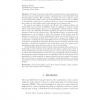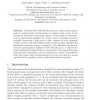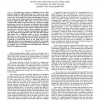82 search results - page 3 / 17 » Tight bounds for clock synchronization |
FOCS
1993
IEEE
13 years 10 months ago
1993
IEEE
: Weprove tight bounds on the time needed to solve k-set agreement, a natural generalization of consensus. We analyze this problem in a synchronous, message-passing model where pro...
ALGORITHMICA
2007
13 years 5 months ago
2007
We study the problem of providing a sensor with an accurate estimate of the time, from a novel perspective which is complementary to the well-studied clock synchronization problem....
CORR
2008
Springer
13 years 5 months ago
2008
Springer
We define the "Pulse Synchronization" problem that requires nodes to achieve tight synchronization of regular pulse events, in the settings of distributed computing syste...
PODC
2010
ACM
13 years 9 months ago
2010
ACM
We study the problem of clock synchronization in highly dynamic networks, where communication links can appear or disappear at any time. The nodes in the network are equipped with...
ISCAS
2005
IEEE
13 years 11 months ago
2005
IEEE
— Recently power becomes a significant issue in clock network design for high-performance ICs because the clock network consumes a large portion of the total power in the whole s...



